 |
    |
        |

Neue Photographische Gesellschaft (NPG)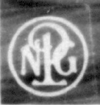
A young East Prussian, Arthur Schwarz, founded NPG in 1894, renting a building in Schöneberg near Berlin. He marketed photographs and supplies, including stereoscopes. Within three years NPG had outgrown its rented quarters and Schwarz purchased a spacious complex in Berlin-Steglitz. At its peak, the company was a pioneer in color photography, had more than 1000 employees, and included subsidiary offices in London, Paris, Rome, and New York. Due to the impact of the war, NPG closed the Steglitz plant in the winter of 1921-22, and its name passed to a firm in Dresden. NPG photographs and stereographs almost always bore NPG logos. On stereographs, a 3 mm logo appeared in the lower left corner of the left image. The style of the logo changed over time. During the World War One period, the company used the style at right. NPG printed stereographs on heavy photo paper and did not mount them on cardboard, although retailers occasionally did.
The first NPG war set was issued shortly after the war began in 1914. It consisted of 100 cards, each marked Krieg 1914. The cards were numbered 1-100. In 1915, the name of the series was changed to Krieg 1914-15 and cards 101-231 were added. The zenith of the NPG World War set occurred in 1916. The Krieg 1914-16 set added stereoviews 232-411 and included a large prisoner of war (POW) section. The latter bore the POW Camp (Gefangenenlager) name instead of the series name.
1917 was a time of increasing privation and disillusionment for the German populace. The successful conclusion of the war against Russia was offset by the impending entry of the United States on the side of the Allies. Fewer cards were added in the last two years of the war, and those appear not to have had series names. Throughout the war, existing stocks of older cards with their original series names were used in newer sets; they apparently were not annotated with the new series name unless the images changed or new publication runs were required. Probably in the immediate postwar period a revised set with the name Weltkrieg (World War) was created; many earlier cards were republished with that name. The final NPG Weltkrieg set, identified by a distinctive font and an "S" prefix to the numbers, may have been produced after the remnant of the company relocated to Dresden.
NPG Markings on World War Stereoviews
| Years & Image Nrs. | Series Markings |
| 1914
1-100
Title List Images |
|
| 1914-15
101-231
Title List Images |
|
| 1914-16
232-411
Title List Images |
|
| 1917-18
412-505
Title List Images |
|
| 1918-20 1-505 | |
| Postwar 1-505 |
The American firms Keystone and Underwood & Underwood purchased stereoviews from NPG as early as 1915. Keystone bought about two dozen views and Underwood one dozen. The NPG logo was not used on American versions. NPG stereoviews provided only a small degree of balanced coverage of the war, since neither manufacturer included as many images of Central Powers troops as Allied troops, and the captions were rarely written favorably. Several years after the war, Keystone purchased from NPG’s successor company the rights to more than two dozen additional NPG images for its definitive 1932 World War set of 400.
One NPG stereoview used by both Keystone and Underwood showed a German memorial to fallen comrades. Some of the images used in the American sets of the early war years were older ones not used in then-current NPG sets. One of these showed a German machine-gun unit, supposedly in Belgium, but it was more likely taken during a prewar exercise. It was used by both American companies, probably inadvertently.
| Keystone
18072—German Soldiers’ Graves and Crude Monument for the Men Who Fell
on the Eastern Battle Lines.
(also Underwood 12266 and NPG 153) |
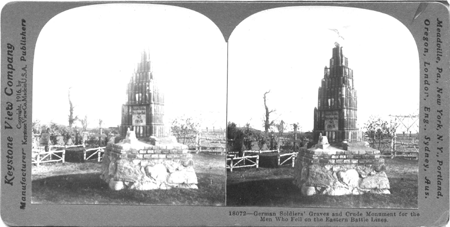 |
| Keystone
18029—German Machine Gun Division in Action (European War)
(also Underwood 11948) |
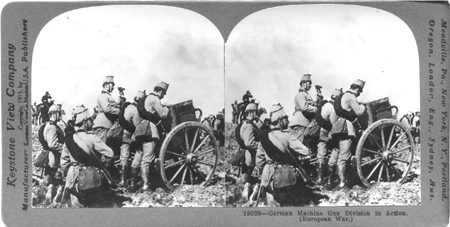 |
One of Keystone’s most popular stereoviews shows the Zeppelin LZ-3, which entered military service in 1909. NPG did not use it in their own World War sets, probably because it was a prewar image.
| Keystone 18000— A Bird of Prey - Zeppelin Flying Over a German Town (later titled "Zeppelin Flying Over a German Town - Lower Valley of the Rhine") | 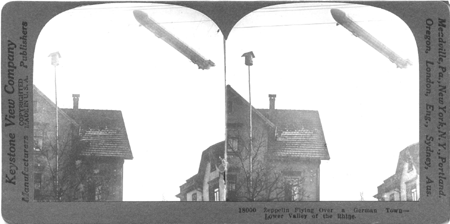 |
According to the 1914-16 NPG catalogue (Stereoskop-Bilder aus dem Weltkrieg 1914-1916), the World War set had three major sections: Pictures from the Front, Pictures of German POW Camps, and City- and Landscapes of Occupied and War Zones. The latter were standard prewar travel scenes and appear to have been only rarely sold with the actual war stereoviews. The Weltkrieg catalog listed 1,688 of the city- and landscapes associated with the war, but a footnote says the full collection of city- and landscape pictures included over 16,000 images; the catalog was available for 50 pfennigs with an order of at least 20 pictures at 30 pfennigs apiece.
Structure of the 1914-1916 NPG World War Set
| Section Name | Translation | Views |
| A. Bilder von der Front | A. Pictures from the Front | |
| Unsere Feldgrauen im Kriege | Our Troops in the War | 32 |
| Bilder aus d. Schützengraben | Pictures from the Trenches | 30 |
| Bilder vom westlichen Kriegsschauplatz | Pictures of the Western Theater of War | 34 |
| Bilder vom östlichen Kriegsschauplatz | Pictures of the Eastern Theater of War | 105 |
| Bilder aus den Kämpfen in der Bukowina, Galizien und Wolhynien | Pictures of the Battles in Bukowina, Galicia, and Wolhynia | 55 |
| Bilder vom Balkankriegsschauplatz | Pictures of the Balkan Theater of War | 31 |
| Das Sanitätswesen im Kriege | The Medical Service in the War | 21 |
| Heerführer | Army Leaders | 4 |
| Skulpteren berühmter Heerführer | Sculptures of Famous Army Leaders | 5 |
| Der Seekrieg | The War at Sea | 10 |
| Kriegsgefangene und Kriegsbeute | Prisoners of War and Booty | 12 |
| Jung-Deutschland | Young Germany | 6 |
|
Total, Section A: |
345 | |
| B. Bilder aus deutschen Kriegsgefangenenlagern | B. Pictures of German Prisoner of War Camps | |
| Gefangenenlager Wünsdorf | Prisoner of War Camp Wünsdorf | 57 |
| Gefangenenlager Döberitz | Prisoner of War Camp Döberitz | 32 |
| Gefangenenlager Müncheberg (added after catalogue was printed) | Prisoner of War Camp Müncheberg | 19 |
|
Total, Section B: |
108 | |
|
Total Military Views, Sections A & B: |
453 | |
| C. Städte- und Landschaftsbilder aus den besetzten und den Kriegsgebieten | C. City- and Landscape Pictures Of Occupied War Zones | |
| Belgien | Belgium | 313 |
| Russland | Russia | 283 |
| Oesterreich | Austria | 525 |
| Italien | Italy | 144 |
| Türkei | Turkey | 62 |
| Griechenland | Greece | 84 |
| Aegypten | Egypt | 197 |
| Marokko | Morocco | 30 |
| Japan | Japan | 50 |
|
Total, Section C: |
1,688 |
Section A illustrates that, as was the case with the other major combatants, Germany had stringent censorship regulations. The German General Staff used NPG stereoviews to reassure the home front and to counter Allied propaganda. Recurrent themes included:
"Our troops" ("Unsere Feldgrauen") are well-cared for, well-equipped, well-led, and happy. As did the French and British, the Germans eschewed images of the gritty reality of life in the trenches in favor of those portraying life in combat as akin to camping in the outdoors. The most unpleasant activity shown was hunting lice.
Austro-Hungarian allies are capable, loyal, true comrades of the Germans. The reality was that, apart from providing the heavy artillery that helped reduce enemy fortresses, Austro-Hungarian involvement in the war was largely negative for the Germans. After suffering crushing 1914 defeats at Lemberg and in Serbia, Austro-Hungarian armies would only fight when stiffened with German troops. Nearly one-quarter of the NPG set portrayed Austro-Hungarian forces, including more than 80 images from the Galician and Balkan theaters, which were overwhelmingly Austro-Hungarian.
The Russians wantonly destroy German territory. Variations of the word zerstören (to destroy) appear in the titles of 40 images, the majority of which explicitly or implicitly credit the destruction to Germany’s enemies. This was especially true for the Eastern Front, where the Russians were specifically charged with the destruction 19 of 30 times. This propaganda theme may account for the set including three times as many views of the Eastern Front as the Western Front (105 views vs. 34), where the German forces were the invaders, hence largely responsible for the destruction there.
Feldgrauen treat defeated civilians kindly. In a direct counter to Allied charges, two images show German "barbarians" ("Deutsche ‘Barbaren’") in occupied territory with smiling, happy children and parents.
| NPG
200. Deutsche "Barbaren" im Feindesland II.
German "Barbarians" in the Enemy’s Land II. |
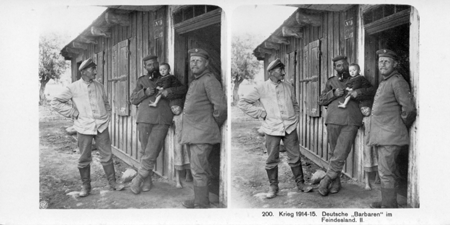 |
Treatment of the dead not only reflected stringent censorship, but may have revealed traditional German prejudice against Russians. No dead German or Austro-Hungarian soldiers were shown, only soldiers’ memorials and cemeteries referring to the "heroes" ("Helden"). French and English dead were similarly not in evidence, but Russian corpses were shown being carried around and buried in mass graves. A sub-series of eight views (66-73, spanning the Eastern Front and Bukovina, Galicia, and Wolhynia) showed Austro-Hungarian soldiers collecting Russian dead and placing them in mass graves. One of these stereoviews shows a stretcher party taking a break by a Russian corpse.
| NPG
70. Rast der Leichenträger bei den toten Russen.
Stretcher Party Taking a Break By a Dead Russian. |
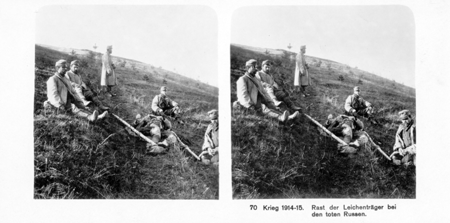 |
A unique aspect of NPG World War sets was the inclusion of a series of five stereoviews showing sculptures of war leaders. These works may have been commissioned by NPG. All were created by a prominent Berlin sculptor, Professor Gustav Eberlein (1847-1926). Eberlein was a highly successful artist with an international following, although he became too closely tied to monuments to the Kaiser’s regime and died destitute.
| NPG
111, Krieg 1914-15. Generaloberst von Kluck. Prof. Gust. Eberlein.
Colonel General von Kluck commanded the 1st Army on the German right during the invasion of Belgium and France in 1914; he was wounded in early 1915 and retired from active service. |
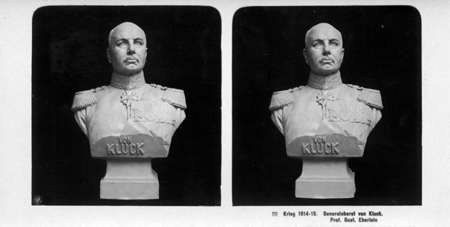 |
| NPG
114, Krieg 1914-15, von Hindenburg, der sieghafte Führer der Ostarmee.
Prof. Gust. Eberlein.
Field Marshal von Hindenburg, victorious leader of the Eastern Army, became in 1916 the Chief of Staff of the German Army. |
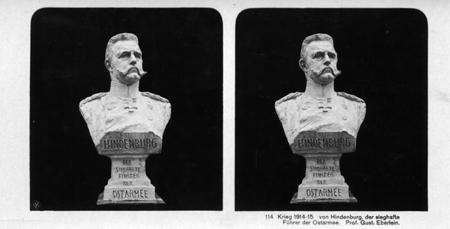 |
Of the 500-plus published NPG war images, more than 100 showed prisoners of war. This sizable treatment constituted a rebuttal to Allied claims that their prisoners were housed in filthy, unheated temporary quarters, fed grossly inadequate food, and denied rights guaranteed under international law. The Central Powers are generally credited with taking over four million prisoners in the course of the war. There were POW camps and facilities in over 320 towns and villages within Germany alone and many more in Austria-Hungary and occupied territories. Even for a country not suffering from the effects of a blockade, the sheer scale would have required use of temporary facilities like stables and tents, so the Allied complaints were probably well-founded. NPG, no doubt at the behest of the General Staff, produced a series showing three of the hundreds of POW camps. The three (Wünsdorf, Döberitz, and Müncheberg) appear to have been purpose-built and were probably the best of the lot. The series reflected propaganda themes countering specific Allied complaints:
POWs are housed in comfortable, clean barracks with access to kitchens, theaters, hospitals, and fire stations.
In those inevitable circumstances where Allied prisoners die, they are given decent burials in well-kept cemeteries.
The camps offer gainful employment for those prisoners desiring to work.
All of the various nationalities and races are treated equally and fairly.
Every prisoner, whether Christian, Jew, Hindu, or Muslim, has access to an appropriate religious facility.
| NPG
344. Gefangenenlager Wünsdorf. Hindutempel in der Indier-Baracke.
Wünsdorf POW Camp. Hindu Temple in the Indian Barracks. |
 |
| NPG
401. Gefangenenlager Döberitz. Schuhmacherwerkstatt.
Döberitz POW Camp. Shoemaker’s Workshop. |
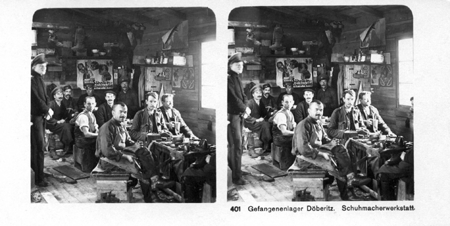 |
| NPG
427. Gefangenenlager Wünsdorf. Vor der Moschee.
Wünsdorf POW Camp. In front of the Mosque. |
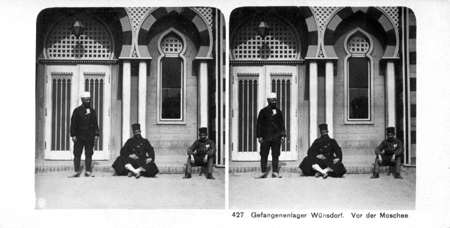 |
| NPG
447. Gefangenenlager Müncheberg. Franzosen, Belgier und Engländer in
den Kojen ihrer Baracke.
Müncheberg POW Camp. French, Belgians, and English in the Bunks of Their Barracks. |
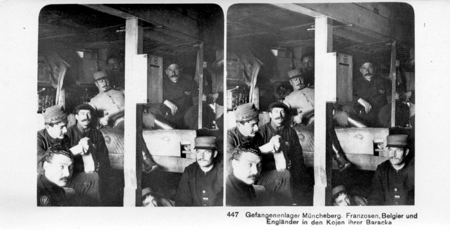 |
Standard NPG stereoviews were in black-and-white, but at least one retailer made colorized versions. M. Rohmer, Leipzig-Gohlis, displayed exceptional skill in coloring NPG stereoviews by hand.
NPG’s extensive coverage of Austro-Hungarian troops not only served propaganda purposes for the German home front, it gave NPG another major market. NPG sold standard German-language stereoviews within Austria proper and published stereoviews in Hungarian to reach other areas of the Dual Monarchy. The structure was similar to that of the German sets, but the largest section covered the Austro-Hungarian theater of Galicia, Bukovina, and Wolhynia. For the other sections, NPG selected images showing Austro-Hungarian troops when possible and minimized the number showing German troops.
Among several reverses for the Central Powers in 1916, Austro-Hungarian Emperor Franz Josef died on 21 November. NPG produced a series of ten stereoviews showing his state funeral.
Copyright © 2007 Great War Photos. All rights reserved